With Gil Dekel, PhD.
Download FREE PDFs Templates, images & resources for your workshop, click here.
Art activities:
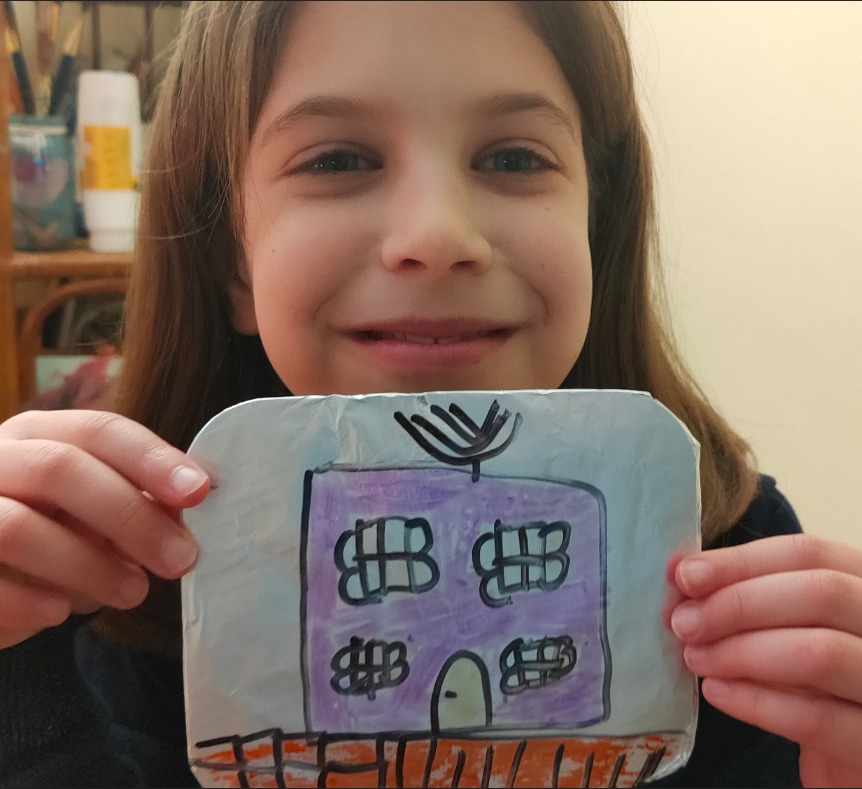
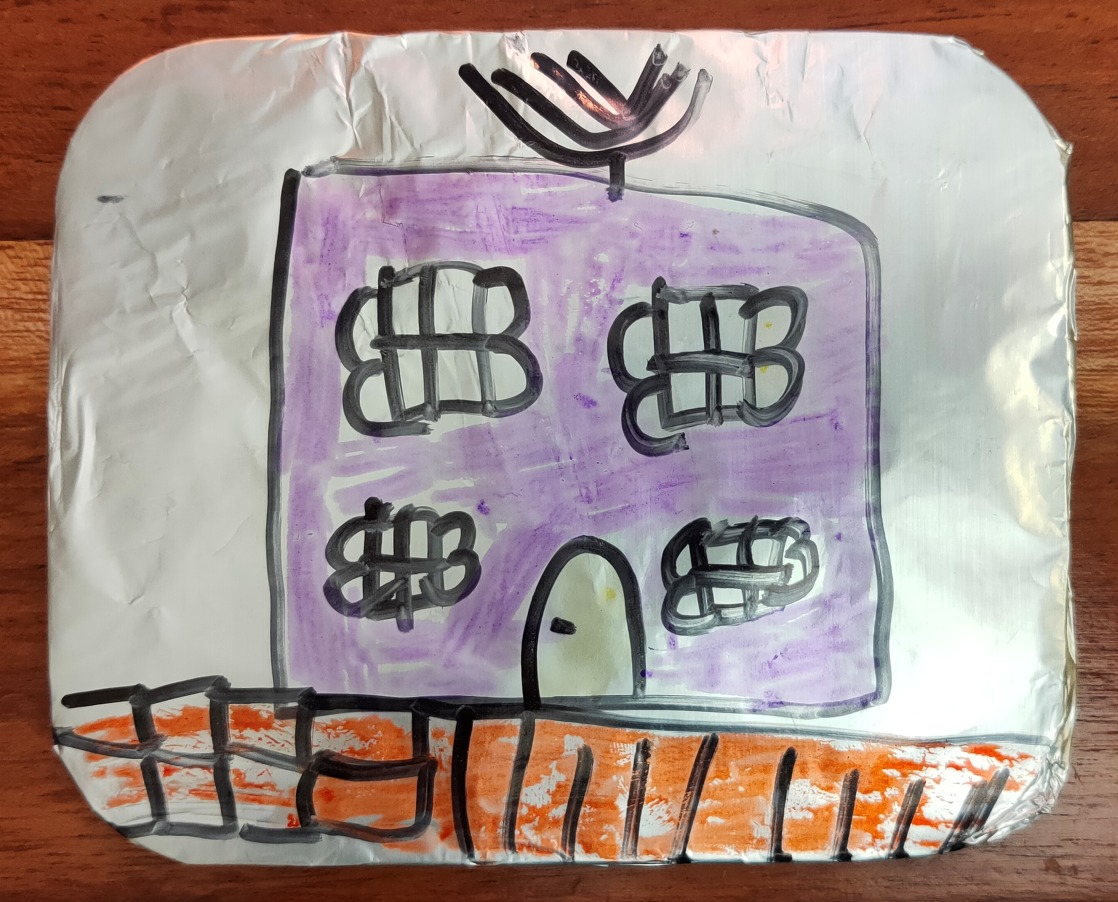
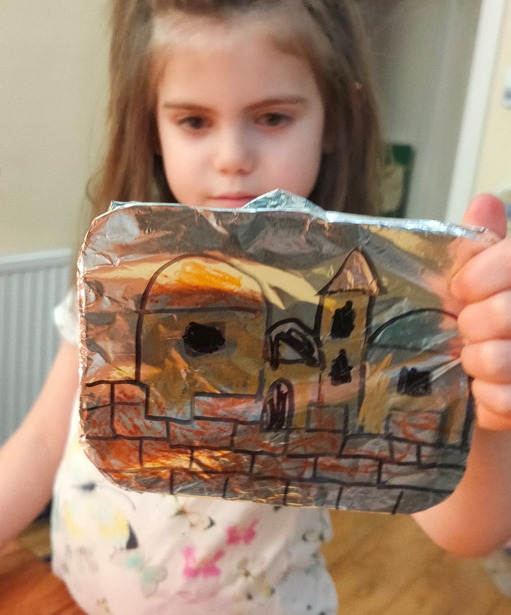
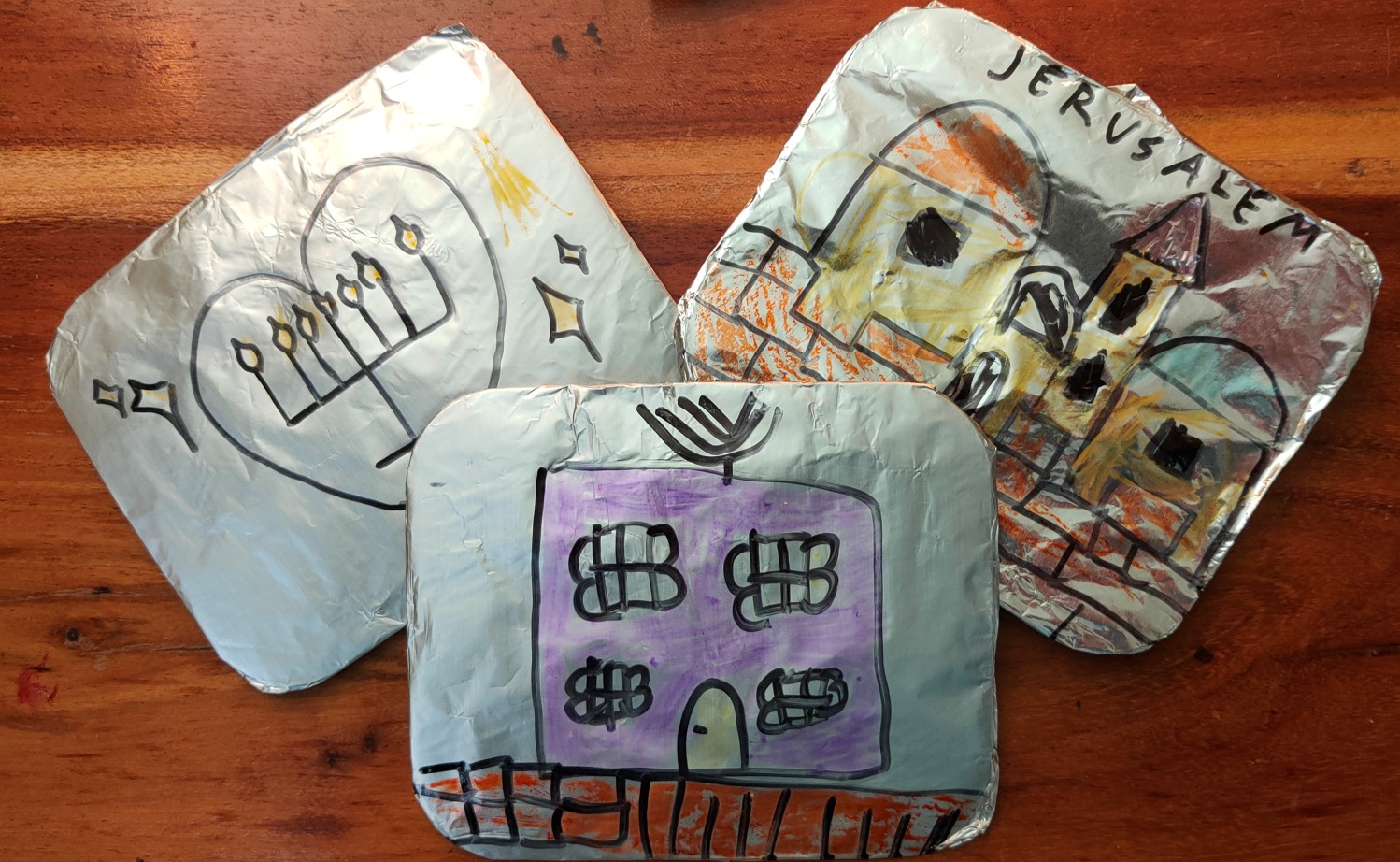
Kitchen foil art – wrap the foil around a card, and paint Jerusalem and The Temple. Kitchen foil has a shiny side, and non-shiny. Remember to draw on the non-shiny side.
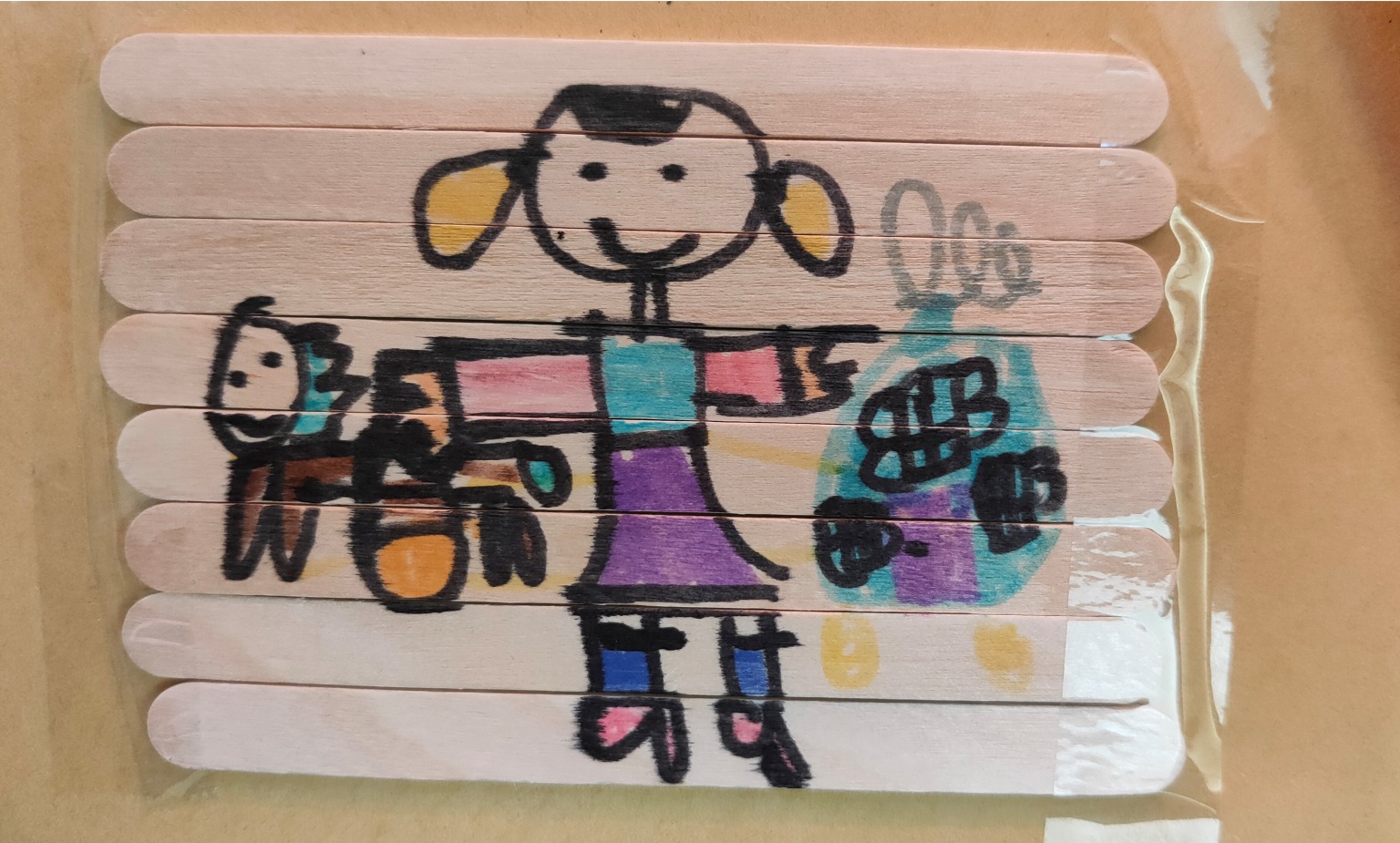
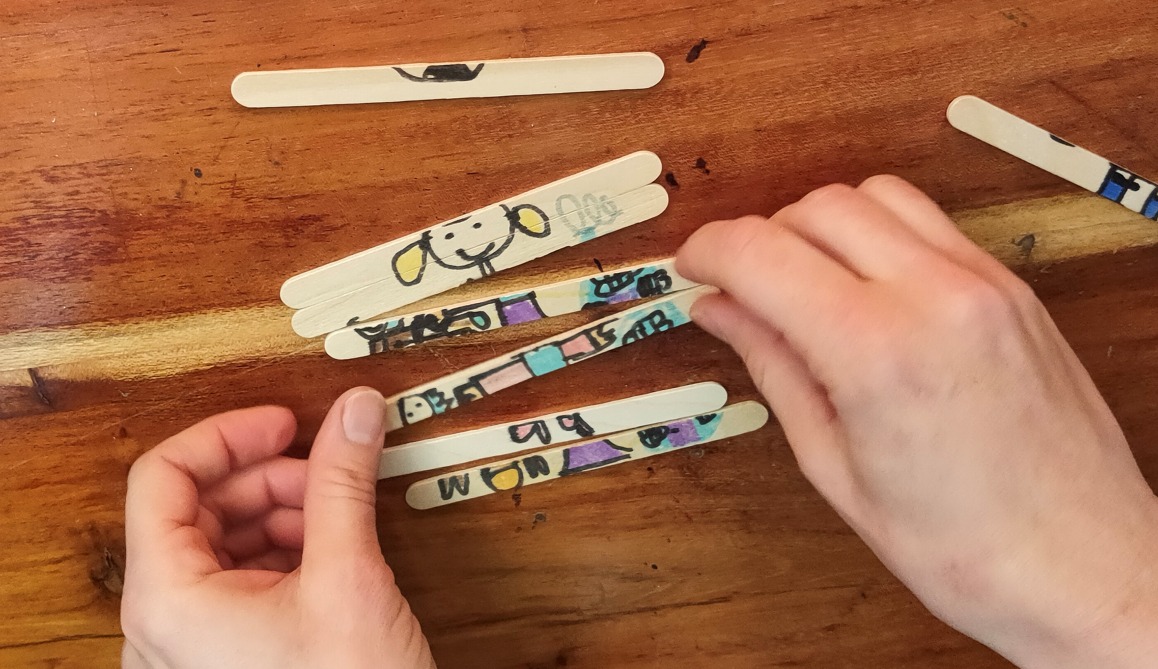
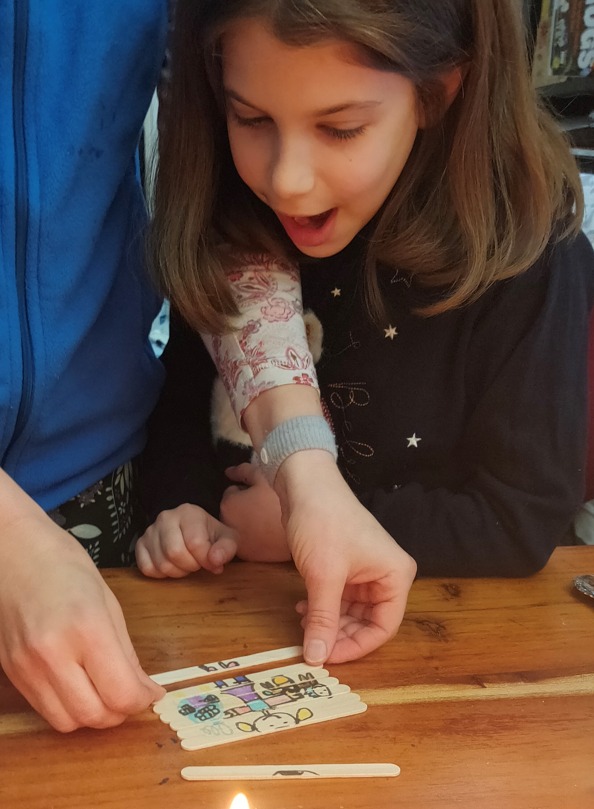
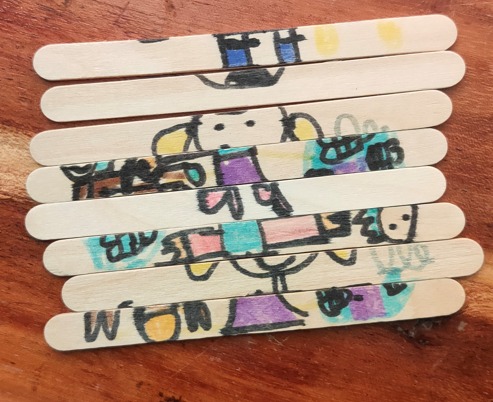
Lolly sticks puzzle – draw on the wood sticks, and play a puzzle game. Ideally, you want to draw a Hanukkah scene, although here we drew a princess…

Svivon – Spinning toy, from bottles’ caps. You can also decorate and paint over it.
2022 Video transcript [click tp open]
I will tell you a bit about Hanukkah.Hanukkah is a celebration that the Jewish people celebrate. It’s a celebration of light. And it tells the story of re-dedication, purification of the temple, old temple that stood in Jerusalem.
This is Jerusalem. Jerusalem is the capital city of Israel. And it is sometimes known as the City of Gold; the City of Gold – Yerushalayim Shel Zahav – the City of Gold, because when the sun sets in Jerusalem, and when the sun lays on the bricks, on the big stones, it does look like gold, red goldish colour.
Sometimes even when you go inside buildings, it looks like gold inside. The whole city is made of stones.
In Jerusalem some 2500 years ago, stood the Jewish temple.
It’s called Bet HaMikdash. Bet HaMikdash HaSheny. 2500 years ago, there was a temple in Jerusalem.
The Jewish Temple was the soul of Jerusalem; of all of the city of Jerusalem.
And people would come from all over the country to celebrate, at least once a year, you had to come to Jerusalem, even if you lived up North once a year, it was a good deed – a Mitzvah – a good deed to come all the way to Jerusalem and celebrate.
The structure is really interesting. Can you imagine what the structure, the shape of the building, means?
The shape of the building is based on a lion. Can you see the lion with the big mane, the big crown, around him. That’s the head of the lion. And this is the head of the lion, right there with a big crown. That’s the body of the lion.
That’s because the lion is the king of all the animals and Bet HaMikdash, the temple, Bet HaMikdash HaSheni that stood to 2500 years ago in Jerusalem was the temple of God, and God is the king of all human beings.
So, the temple was the soul of Jerusalem.
Later on, we will make this pop-up Bet HaMikdash. I will give each child a template temple.
When you open it, Bet HaMikdash will show up…
3D pop-up Bet HaMikdash. We will all make that, HaMikdash in Jerusalem.
If you went to the temple. You walked up here and you enter there, you go inside over there, you will see a big hall.
That’s what you see inside the temple.
Look at that. That’s a massive, massive hall at the back. At the back it says Holy of Holiest – Kodesh HaKodashim. That was the real structure of Bet HaMikdash; that’s how it was 2500 years ago.
There was this red curtain, so big, 20 metre high.
Red curtain and behind the red curtain, I can’t see, but behind was Kodesh HaKodashim, the holy of holiest, that was the most sacred space in the Jewish tradition.
Nobody could go inside, it was so sacred.
So special.
Only the high priest, high priest – Kohen Gadol – he would sometimes go inside.
Kohen Gadol was wearing something really interesting, an interesting jewellery… 12 gems 12 stones.
The 12 gems that he was actually wearing – each stone represents one tribe of Israel.
In Israel we had 12 tribes, the 12 Sons of Israel, and each stone represents one tribe.
The Kohen Gadol, the high priest, he would wear it. He would actually wear it inside Bet HaMikdash.
And you see here, he’s standing next to this Menora.
This Menora is a big candelabra. It’s like two metre high. It’s like higher than me…
And you know what it was made from? Yeah, gold you said? you are right.
This was solid gold. Solid gold means that it was made only from gold, nothing else. There was nothing inside of it apart of gold.
And the 12 tribes… each tribe gave some gold. Each tribe gave some gold, and they made this Menora, this Hanukyia – it is called Hanukiya or Menora, from the gold that all the Jewish people, the sons of Israel, gave.
A pure Menora from gold.
And they did not have candles like we have today. They use oil.
They would pour the oil inside, they also had wick; and they would use oil to light up this candelabra, the Menora.
This is the symbol of the modern state of Israel. It is probably based on a plant, which is found in Israel.
Seven branches. Today we have nine; then we only had seven – I will tell you later why.
And so, the Kohen Gadol, with this jewellery, he would dedicate, bless the oil, and only that oil which he blessed, they would use every day to light up this candelabra, this Menora.
Later on, we will make this Hanukyia. I have a template. This is so cool. This is a Hanukiya which is made from this card that we will actually fold; I will fold it with you. And cloths pegs.
Pegs. I’ve got some pegs here.
So, for many, many years, the Jewish people, were under the rule of the Greek Empire, the great Greek empire.
And the Greek Empire was good. They allow people to practice their religion with no problems, for many, many years.
Until the Greek Empire broke into different states; many different states. And they started to fight with each other.
One state is called Assyrians, it was next to Israel. And they had a ruler called AntiYochus, he wasn’t very clever. He forced people to practice different religions. I don’t know why, but he did not give them the freedom to practice what they wanted.
AntiYochus sent his soldiers, around the year of 200 BCE, so some 2200 years ago, into the temple, into the holly Bet HaMikdash. And he put a big statue. And he said to the Jewish people: you have to pray to that statue.
Jewish people do not pray to a statue, to stone, they don’t pray to stone because God is bigger than anything; bigger than all stones…
God is all of us combined.
So, what the Jewish people did – as AntiYochus didn’t allow them to study Torah, to study their religion – what they did is to study Torah, the Jewish Book, in hiding.
And when Assyrians soldier of AntiYochus would show up, they will use this Svivonn. They will pretend that they’re playing.
All the children will take the Svivonim out, and they would pretend that they’re playing the Svivon, so that they could actually practice their faith.
AntiYochus said: I don’t like this, so he went into the temple into Bet HaMikdash, and all the oil they used to light the Menora. He destroyed it. All the oil jarsm he took and broke, and he made a lot of damage inside Bet HaMikdash, until this group of people stood up.
A small group of Jewish warriors called Macabim. Yes, it says: Me Camocha BaElim – that’s the meaning of the name.
And this Jewish group, Macabim, they fought back, they said: we’re not going to let you destroy Jerusalem.
But how can a small group of people fight a massive army?
A small, tiny group, only a few thousands fighting this big army… there’s no chance they could win.
But then a miracle happened. The Macabim had a little special thing by which they could win. It’s called Hanukkah light sabers… I’ve got a few lights, sabers here.
They took the light saber, and they woosh it like that. And sometimes they had two.
Yehudit HaMacabit – she had two. And when the Assyrian soldiers came, she went like this, and like that, and each time she was going like this or like that, she flicked the light, and the light scaled all the Assyrian soldiers, and they ran away. And that was the first miracle. And she went like this…
And like that. Like that. Each time she was flicking the light. That’s why we say: the celebration of light over darkness. That was the first miracle of Hanukkah.
When they managed to drive away the Assyrian AntiYochus away from the temple, that was the first miracle, the miracle of a small group managing to drive away the big group of soldiers. And so today we use Svivonim, those spinning toys that the children would use, and we have Hebrew letters on them.
The Hebrew letter say: a big miracle happened. Nes Gadol Hayah Sham; Shams mean there. If you’re in Israel, the miracle happened where you are; not ‘Sham’, it happened here in Israel. So you say Nes Gadol Hayah. What’s the last letter?
‘Po’.
You got an extra doughnut…
‘Po’ means here. If you’re in Israel, a big miracle happened here…
This is the first known event where a small religious group is fighting for a religious emancipation.
The earliest known story where a group say: we don’t care; we want to practice our own faith. That’s why Hanukkah is so important.
Later on, we will give you a Svivon, spinning toy, made form marshmallows, and you can choose which letter you want, and Natalie will draw the letter for you and she will give it to you.
After the Macabin drove the Assyrian, AntiYochus soldiers away, they went back to the temple, and they couldn’t find anything, but there was a little child who was I think, five years old.
How old are you? 10. So she was a bit younger than you. And she crawled and under the staircase, she found only one single jar of oil left untouched. Everything else was desecrated, was broken, but there was only one which was sealed, sealed with the stamp of the Kohen Gadol, which means the oil was pure.
They found the Menora, they cleaned it, they put it back and they use the oil. But the oil would last for only half a day. They went home and they said: oh, never mind, the light will not last…
But they came back the next day. And still the light was burning, two days. Now this oil should last for one day, but it’s lasted for two days. So, they cleaned the temple, Bet HaMikdash, and went home and say: oh, never mind, it will not last longer. But two days is good.
They came back the next day, three days, the light stood; this little oil jar was still consuming, the light was burning for three days. Four days, five days, after six day what do you think happened? After six days? When they came back to Bet HaMikdash, what happened, Natalie?
Yes, the light still burned, seven days… eight days, the light stood. And that was the second miracle of Hanukkah.
A little jar of oil that should last for one day stood for eight days; then they could find more oil.
Eight days… if you put the number eight on the side, it represents eternity. This is the symbol of eternity, of continuation, of ongoing.
And that was the second miracle.
This is Menora in Jerusalem today, in real life, standing behind the ruins of Bet HaMikdash, the temple whatever was left. That’s what is left in Israel.
And because the miracle carried over eight days now we have eight branches to represent the eight days; there’s another, nine. The ninth is the Shamash, the service. So originally, we had only seven. Now we have nine, we added another one; another day of party… that’s why…
Later on I will project this and you will help us to light the Menora. Each child… Aer you a child, Yael?
No…
So you just might get one…
I’ve got this, and this is for you, you can take it home. This is so cool. Look what we’ve designed…. That’s why we study graphic design at the university…
You’re holding this and if you click, look at that… and you’ll have to put the flame in the right place later on. Okay, each child will have to put it, and then one will be the Shamash. So, you will help us to light the Menora.
The third one from top, since there is a red line underneath indicating a spelling mistake…
Another miracle that happens in Hanukkah is the many spellings of Hanukkah in English. The list goes on and on… I must admit this is my invention. Nobody uses this spelling in this country. But that’s how I use it. So all the spellings are correct, because it’s Hebrew, transliteration, apart from one spelling. Can you guess? there is a hint? Who can guess which spelling is not right?
Yes, so Yael picked correctly… this is just to show you how Microsoft PowerPoint dictionary is powerful. It did recognise all of the spellings, apart of this which is my spelling, so I went and I added it to the dictionary, which mean that now Microsoft knows that this is also correct.
But you see the one at the top there. You see the double n? That’s the one, which is not correct.
Every else spelling has one ‘n’.
So you can spell it with a ‘ch’, or with an ‘h’, or with a ‘k’ or two ‘k’. And it’s all correct. And that is the third miracle that nobody will tell you… it’s a secret… Don’t share it with anyone. There are so many spellings.
And because it was a miracle of oil, it was a miracle about oil, we’re eating Sufganiyot, doughnuts like this one, which I went to the shop today and I couldn’t find it, so you’re gonna have an alternative. Nothing to do with Sufganiyot. This is a biscuit, chocolate biscuit. No relation whatsoever to Sufganiyot, but it looks good.
Hanukkah is a celebration of a miracle of oil. And therefore, we eat food that was made with oil, like Sufganiyot, and also potato latkes, that we are baking.
We have chocolate coins, to remind children about charity, to give charity. And we play the Svivon game.
In this holiday, you see the Hebrew prayer at the top? It’s going to sound funny. Do you want to hear it in Hebrew? Or in English? Who wants to hear it in Hebrew? Okay, who thinks they will understand it in Hebrew?…
One, two, okay.
So the basic of the Hebrew prayer is about two things. Al HaNisim, here at the top, which means the miracles.
And Al Haniflaot, which means the wonders.
In Hebrew at the top, it says: thank you, God; Al Hanisim, Al HaGvurot, Al HaTeshuot, Al Haniflaot, thank you, God for all these things you have done, that you have carried in those days, those days meaning 2000 years ago, and it says at the end: at this time.
Those days, at this time. Those days, i.e. 2000 years ago; at this time, meaning 25 of the month of Kislev, the Jewish month of Kislev, meaning around December, the start of December. And then there’s a question: what’s is different between a miracle and wonder? Why do we thank God for both the miracles and the wonders that he did for our forefathers?
Miracles, miracles in Judaism, Al Hanisim, means all the natural functions of nature. Nature is miraculous. The fact that leaves fall from trees in winter is not just by accident. We believe that it is a miracle. We believe that God governs it through science, that God governs science. So we call it a miracle. So we thank God for all the miracles that he performed. Also, we thank God for the wonders; wonders is our ability as human beings to appreciate the miracles. Some people don’t appreciate the miracles. They think it’s natural (normal) whatever happens there. But we say it’s wondrous, we have the ability to be inspired by the miracles, and we thank God for both of those miracles and those wonders.
Now, let’s do some art activities. Yes?
2023 Video transcript [click tp open]
Everybody knows what Hanukkah is? Yes, Hanukkah happens now; it’s a time of celebration when we celebrate light of darkness. And we also celebrate the rededication, which is the purification of the Jewish temple. This is the second Jewish temple that stood in Jerusalem, in Israel, 2500 years ago. The Second Temple, and there was a miracle, a miracle that happened in that temple. I will tell you all about it.
00:31
Now, the story of the Jewish people, begins much before the temple; even before the temple. The story of the Jewish people begins with this man, Avraham Avino. Avraham our father, forefather was born 4000 years ago. Avraham was born 4000 years ago outside of Israel in a place called Ur Cashdim. Can you say Ur Cashdim? Ur Cashdim. And when he was 75 years old, that’s like, four times your dad… 75 years old, God came to him and God said: Avraham, I want you to collect all your belongings and all your family. And I want you to go from Ur Cashdim on a journey. Start walking to a place that I will show you. And so Avraham, Avraham Avinu took all his belongings and all his family. And he started to walk. And God brought him to the State of Israel, to the country of Israel. And God told him: that is the place where you’re going to live. Avraham lived in many cities in Israel for many, many years. And he had a son – Yzhak, and a grandson which is Ya’akov. Avraham, Yzhak, and Ya’akov. are the three forefathers of the Jewish nation. And they lived in all the cities of Israel. And when he died, Avraham and his wife, Sarah died, they were buried in this cave, known as Mea’rat Hamachphela, can you say Machphela?… in Israel, Avraham actually bought this land. He paid for that land, and he bought it. And he had children and grandchildren, and grand-grandchildren. And they became a big nation in Israel, consisting of 12 tribes.
02:23
These are the 12 tribes, 12 Jewish tribes that livedin different sections in Israel, and each tribe, your forefathers, each of those tribes, they had a special job. Each tribe had a special job they had to do in Israel. And each one also had a special symbol. So these are the 12 tribes of Israel. And they lived, the 12 Jewish tribes lived like that in Israel for many years, until King David united all the separate tribes into one country. This is the United Kingdom of Israel. That is the first time the Jewish people lived in autonomy, which means they ruled the land and they ruled the country. That is under King David. King David is your great, great, great grandfather. And that is the United Kingdom of Israel, 3000 years ago. 3000 years ago, the Jewish people lived under their own autonomy in Israel under King David, in the United Kingdom of Israel. And today we live in… today we live in the United Kingdom. God bless this beautiful country of ours, the United Kingdom. The roots of the Jewish people is also United Kingdom, the United Kingdom of Israel, under King David.
03:41
This is King David. And you can see that he had red hair. King David was very famous for having red hair. And he liked to play the lute. He was an artist. I will tell you a secret. King David didn’t want to be a king. He wanted to be an artist. He was an artist. He was very humble man, you see, playing the lute. But he was so good with people and animals, that even the animals would bow to him. The animals bow to King David, and they made him a king because he was so good, so they crowned him.
04:20
And this mosaic that you see, this artwork that you see here, was made 1500 years ago, after King David, many years ago; 1500 years ago, this mosaic was made. And you can see, it says here in Hebrew: David. I can read it. Dalet, Vav, Yud, Dalet. David. King David. So even 1500 years ago, we used the same Hebrew language that we’re using today. Jewish people have a very long history of language and culture. We can read stuff we wrote many many years ago.
04:59
So King David after he united all the people, he bought this mountain in Jerusalem and said: I’m gonna make Jerusalem the capital city of the Jewish people. And he bought the mountain. He paid for it just like Avraham before him, who paid for the Mearat Hamachpela in the city Hebron. So did King David paid for this mountain in Jerusalem.
05:21
And I remember when I was your age; how old are you? Seven and you seven? Ten years old. When I was almost ten, I think I was eight years old, your age, in schools in Israel, in every class we had a charity box like this one. It’s called Keren Kayemet LeIsrael. In every classroom, we had this charity box. And we would put money to buy lands in Israel, to build a country, like King David before us who paid for Jerusalem, and Abraham before us. We would collect money to build the country.
05:57
And so King David bought this land, this big mountain in Jerusalem, and he built a city, and his son, Hamelech Shlomo, King Solomon, the wisest man of all, built the first Jewish Temple. The first Jewish Temple of King Solomon, in Jerusalem. Thiis is the city of David in Jerusalem.
06:21
Jerusalem is known as the City of Light and Gold, because when the sun sets, the beautiful sun in Israel, which is very bright, when it’s set down, it casts this gold-red light on the beautiful stones, and it looks like gold. Even inside buildings, it looks like gold. I took that photo, that’s inside a building in Jerusalem. And it looks like gold. It’s amazing.
06:52
So the Jewish people built the Second Temple in Jerusalem some 2500 years ago, after the first temple was destroyed, they built the Second Temple in Jerusalem. The temple is really unique because people would come to visit it three times a year, three times a year, they would come to Jerusalem, and they see this fire. This was a fire that was burning 24/7 all the time, it never stopped. 24/7 the light, the fire was burning. Like your Wi-Fi connection. It’s always there…
07:30
And the structure, the shape of the building, the architecture looks very simple to us. But when they built it, it was very special. The structure is modelled after a lion – the shape of a lion. A lion is the shape of the Jewish Temple. The Jewish Temple is called Bet HaMikdash. Can you say HaMikdash? Yes, that’s right. Bet HaMikdash HaSheni, the second temple. And so this is the lion; you see the head with the mane, the hair. So that’s the shape, that’s the head with the mane, with the hair. And this is the body of the lion right there. And this is the body of the temple. Those gold triangles represent the crown of God, because the lion is the king of all animals. Is that right? Yeah, the lion is the king of all animals. Right? That’s the lion. And it’s also the symbol of Jerusalem. And the Bet HaMikdash, the temple, is the symbolic house of God; one God for all people, and God is the King of all kings. We have kings. Well, those kings have another King – that is God. So do the Jewish people believe. If you walk up this staircase from here, all the way up towards the staircase right there, you will reach the big hall. That’s the big hall in the Jewish Temple Bet HaMikdash.
08:56
This is the High Priest – Cohen Gadol – standing next to gthe gold Menora, and behind them is this massive curtain of pure silk. I mean, how high do you think that curtain was? Do you know? How much, 10 metres. Any other guesses? How high was this curtain? 10 metres, or maybe even 20 metre high. 20 metre of pure silk and it was actually hiding something. The curtain doesn’t matter. What matters is what it was hiding behind it.
09:30
Behind it was a sacred room, called holy of the holiest. The most sacred room in the Jewish tradition. Like there was nothing more sacred than this. In Hebrew: Kodesh HaKodashim. Can you say Kodesh HaKodashim? Yes, that’s right. It was there, behind this was Kodesh HaKodashim.
09:53
Now some of you may know if you’ve been last year, but if not, I’ll ask you again. Do you know what was in the most sacred room of the Jewish tradition, the Kodesh HaKodashim? What was in the room. Tora book, the Jewish Book, yeah, and the other guesses? The temple… Yes, this was actually inside the temple. The temple was bigger, and the room was inside the temple, you are right, part of the temple. Any other guesses, what was in the most sacred Kodesh HaKodashim of Jewish nation? Menora, the Jewish Menora was actually outside right there. So in the most sacred room in the Jewish tradition Kodesh HaKodashim was nothing; there was nothing there, it was empty. It was just a space. Because the holiest thing in the Jewish belief is not gold, it’s not stone, it’s not something it is nothing. Only God can create something out of nothing. We human beings, we can create something out of something, I can take wood, which is something, I can carve it and make it into a sculpture. So I’m creating something, sculpture, out of something, out of wood. God, so do Jewish people believe, can create something out of nothing. It’s like your thoughts, ideas and concepts. In Hebrew, we call it: Yesh Mi’ayin. Something that exists out of nothing, whereas we human beings, we can create only Yesh MiYesh, something out of something.
09:53
So in the most second room, there was actually nothing… it is the spiritual connection of you. And that is ‘the image of God. When we say ‘in the image of God’ in Henrew: Betselem Elohim, something people think we mean that we look like God physically, no… The image of God, the image of God means the potential of God to think and to feel and so you can think and feel. All human beings are born in the image of God.
11:56
Remember, when I told you about the 12 tribes… so the high priest had 12 gem stones, each stone represented one tribe. Even under the rule of King David, when they were all united they remembered the 12 tribes.
12:13
Cohen Gadol was the only one who could go to the holy of the holies Kodesh Hakodashim, and only once a year, and he would bless the people and he would bless the food. He would bless people by doing this gesture like that. Do you know this from the TV series, Star Trek? It is connected… The Star Trek symbol was taken from Judaism.
12:39
So Star Trek symbol was invented by Jewish people. Okay, can you do like that? I don’t know if it will affect, because only the high priest (who was from a certain tribe) could actually do the blessing. But we can all do that. Yeah, maybe you are part of the Kohanim… I had to practice to do it. And later on, I will give you a paper template, print paper, you can decorate it and you can draw a rainbow if you want, and do whatever you want on this page.
13:16
So the high priest, he would bless the oil that was used to light the Menora. This is the Jewish Menora. How high was the menora? Probably two metre, two metre of pure gold. Each tribe gave a bit of gold to Beit Hamikdash and form that gold, they made pure Menora, of pure gold. From gold by the tribes. And the high priest, he would bless the oil and he would seal it with a signature. Only the oil that the high priests would bless we could use to light the menorah.
13:52
The Menorah was based on the shape of a plant that they found in Israel. And it had only seven branches. Let’s count seven branches… 1 2 3 4 5, 6 7. That’s right. So it had seven branches. And they would put oil in it and wick. They didn’t have candles in those days; oil and wick, and they would light it with oil. And so the Menorah is still a symbol today in Israel, obviously. Here’s a recent modern Israeli coin. And you see the Menorah, still a symbol of Israel. It says Israel, Israel, Israel, Hebrew, Arabic and English. That’s modern money in Israel, a symbol of the Menora.
13:52
And we have the Menora imprinted on chocolate coin, which I have and I will give you later on. We give children chocolate coins in Hanuka so they remember to give to charity. And so for many years, the Jewish people lived like that with no problems, in the temple, and they were happy that they could practice their religion in Jerusalem, in their capital, until the Roman Empire broke up, the big Empire called Roman Empire, broke up two separate armies. And one army was this with the naughty King Antiochus. Antiochus was a naughty king of the Assyrian army, Asyria was a land just outside Israel. He was really naughty. He didn’t let people practice their religion. It was the first time that any empire didn’t allow people to practice their faith. It was religious persecution at that time; he wanted everyone to do what he want.
15:34
So he sent his trip to Jerusalem, they went into our temple, and they destroyed all the oil and they made a massive mess inside our temple; destroyed all the oil and they put this stone. This is a sculpture of Antiochus in Jerusalem. And they said to all the Jewish people: you now have to pray to us, to Antiochus. Can you imagine that? Jewish people don’t pray to stones. We don’t pray to a stone. Remember, I told you about the Holy of Holies, Kodesh Hakodashim, where there was nothing. Nothing is the real power of God, not a stone, not an image, not a sculpture. So the Jewish people, they refused to pray to that stone. And he told them: You have to pray to that stone.
16:24
And you cannot learn Tora, the Jewish book, anymore. So they refused. They escaped to the mountains. And they would learn Tora in the mountains, hiding. In Jerusalem there are many mountains. And when they saw soldiers coming to check on them that they don’t study Tora, they would hide the Tora book, and they would pretend that they would play Svivon. This is a svivon, they would take it out, and they would pretend to play svivonim, spinning toys. When the soldier went away, they will put the spinning toy back; they would take out the Tora book and they would study the Tora. So later on, I will give your Svivon. I have Svivonim, and you can decorate them later on. We’ll do it. You can take it home. It’s for you. And we also write the letters on Svivonim. I will explain it.
17:15
For a few years we lived like that, hiding in the mountains until this guy, Yehuda Hamacabi and his friend Yehudit HaMacabit, rose to power and they said: We’re not going to have any more of this. We’re going to fight back. This was the first time where a nation is known to fight for its religious independence. It’s the first fight where people fought to have religious independence. And they are called my Macabim, in Hebrew: Mi Camocha Baelim Adonai. Acronym: Macabim. And they said: We’re going to fight back against this evil Antiochus and his evil army. But how would they win? There were not many Jews around so the Maccabim gathered a few thousands warriors. But how can they win against this mighty, mighty army? They had machines, and tens of thousands of warriors. How would they a small Jewish army wim, of only thousands of warriors? So they went to big priest Cohen Gadol, and asked what should we do? The Cohen Gadol told them: I know you only have a few thousands of soldiers and I know the wicked Antiochus army is massive. I know that. But I want you to trust God, trust God and something will happen.
18:39
So they said okay, and the next day they went to the battlefield. They hid in the mountains. And when they saw the wicked army of Antiochus , they said: what can we do, but they really believed and then a miracle happened. God gave them special weapons. First, God gave them a Macabim Light Zappers… Now I have Macabim Light Zappers here, each child each child is going to have a Zapper, and you can take it home with you.
19:11
I’ll show you… see that. This is Macabim Light Zapper. Each child we’ll get one and you can take it home. So God gave them a couple of Light Zappers and when they saw the wicked army, they jumped to them and zapped them with light, like this. And they went like that and they zapped them all around with light. And the Asyrian soldiers couldn’t comprehend, it was too much for them. And they started to escape.
We have a song about light Zappers, called Banu Hosheh Legaresh. We sing the song and we go around the room and every place you see darkness, you will zap it with your zappers. Okay? And the other thing that God did was to give the Jewish people the super bracelet, the super Jewish bracelet. So when they had the bracelet on, and they saw the wicked soldiers they would jump with the bracelet all around the mountains, landing next to the soldiers, like that, in they would zap them and then they could zap themselves out; they could escape. I have a super power bracelet here with me, but I need your help. You will decorate it. Okay, each child can take it home, but you will decorate it with some pens. We will do it very soon.
And God gave them another weapon. He gave them those special shields made with the stones of the 12 tribes; with gems. These shields don’t just protect you, but they will also break the light and they will dazzle the light all into the Asyrian army. I have some gemstones here, which I will give you later with this print template and you can create your own gemstone shields.
21:10
So with these magical tools, the Jewish people, although small in numbers, they managed to chase away the wicked Assyrian army and save Jerusalem. And after they drove the wicked army away, they went back to Bet HaMikdash and Bet HaMikdash was a bit ruined. The Assyrians destroyed it, so they cleaned it up. They put the Menorah up back. But then there was not enough oil. Because the Assyrians desecrated all the oil; they broke it. But there was a young child, I think your age, who crawled and found one jar of oil, only one jar of oil, one bottle of pure oil. One bottle would not be enough, it would last for only one day. So they lit up the Menora. But they said: that would not last long; it would last for only one evening. They cleaned the temple Beit Hamikdash, and they said: never mind; it would last only for one evening. But what can we do?
So they went home. They came back the next day. And the light still stood. The fire was still consuming, that was odd. One bottle of oil should last for one night, and it lasts for a full day. Okay, so they cleaned up the temple and they went home in the evening and they say: well, it will not last long anymore. Never mind, what can we do.
They came back on the second day, and the light still stood. Two nights, two nights and then 3,4,5… 8 nights. The light stood for eight nights, this little jar of oil was able to hold the light. Instead of one day, it was holding for eight days. And that was the second miracle of Hanukkah. And for that reason, we celebrate Hanukkah for eight days. Today. Eight is the symbol of infinity. See, that’s the shape of eight. That means infinity. And because it was a miracle of a day, you remember the seven branches Menorah?… Yes like that. And what could be like that or the side like that. And because it was the miracle of eight days, we now celebrate eight days of Hanukkah and we have eight branches, not seven but eight.
So it’s eight branches plus this which is the ninth. This is called Shamash, the service, you will use that to light the others. So it’s eight branches; nine with the shamash. Eight because of the miracle of Eighth Day. The first Menora had seven branches, and now it has eight. By removing the wicked army, the Macabim helped establish the second Jewish independent state in Israel, Mamlechet HaHashmonaim, a few years later, the second Jewish Independent State of Israel where Jewish lived independently in Israel. Today we have the third Jewish independent state in Israel. And so because it was a miracle of oil, the oil lasted for a day we eat food which is baked in oil like doughnut Sufganiot (we have some), made in oil; also potato latkes, and we give children chocolate coin to remind them of the miracle of charity. We play the Svivon. Today on this revolving spinning job, we write letters in Hebrew.
Nun, Gimel. Hei, Sjin. Nes Gadol Hayah Sham, a big miracle happen there; there in Israel, ‘Sham’. If you live in Israel, you will say: big miracle happened here, not there. So instead of Shin (Sham), you will say Pei (Po) meaning: here. Big miracle happened here. When we light the Menorah, the candles, we say a blessing. We thank God for the miracles, Al HaNisim, and we thank God for the Niflaot, the wonders. What is the difference between miracles and wonders? So, miracles are the function of nature, what nature does; have you noticed that every year winter comes on the right time. Each year you get winter on the right time; winter never fails to come when it needs to come. That’s a miracle. Wonder is our ability to appreciate a miracle. I’ll tell you a secret, some people don’t appreciate the rain. They don’t appreciate the miracles of nature. We appreciate; we thank God for the for the miracles He did and for the wonders that he did for our forefathers at this time of the month, some 2500 years ago.
Many years after the temple was cleaned and stood, it was actually destroyed. The second Temple was destroyed; the only thing that is left today are some bits of the wall. You see, from this column to this one, that’s the only thing that is left intact in Jerusalem. If you stand here today, in Jerusalem you will see the only wall that was left. And we pray that the third temple will be built very quickly in our times. Later on, we will build the Third Temple. We’ve got some cards that we can use to build. Now do you want to do out? So let’s do art. Thank you.
Hanukkah Svivon – Tangram Puzzle Game. Save and print this image, and cut out:
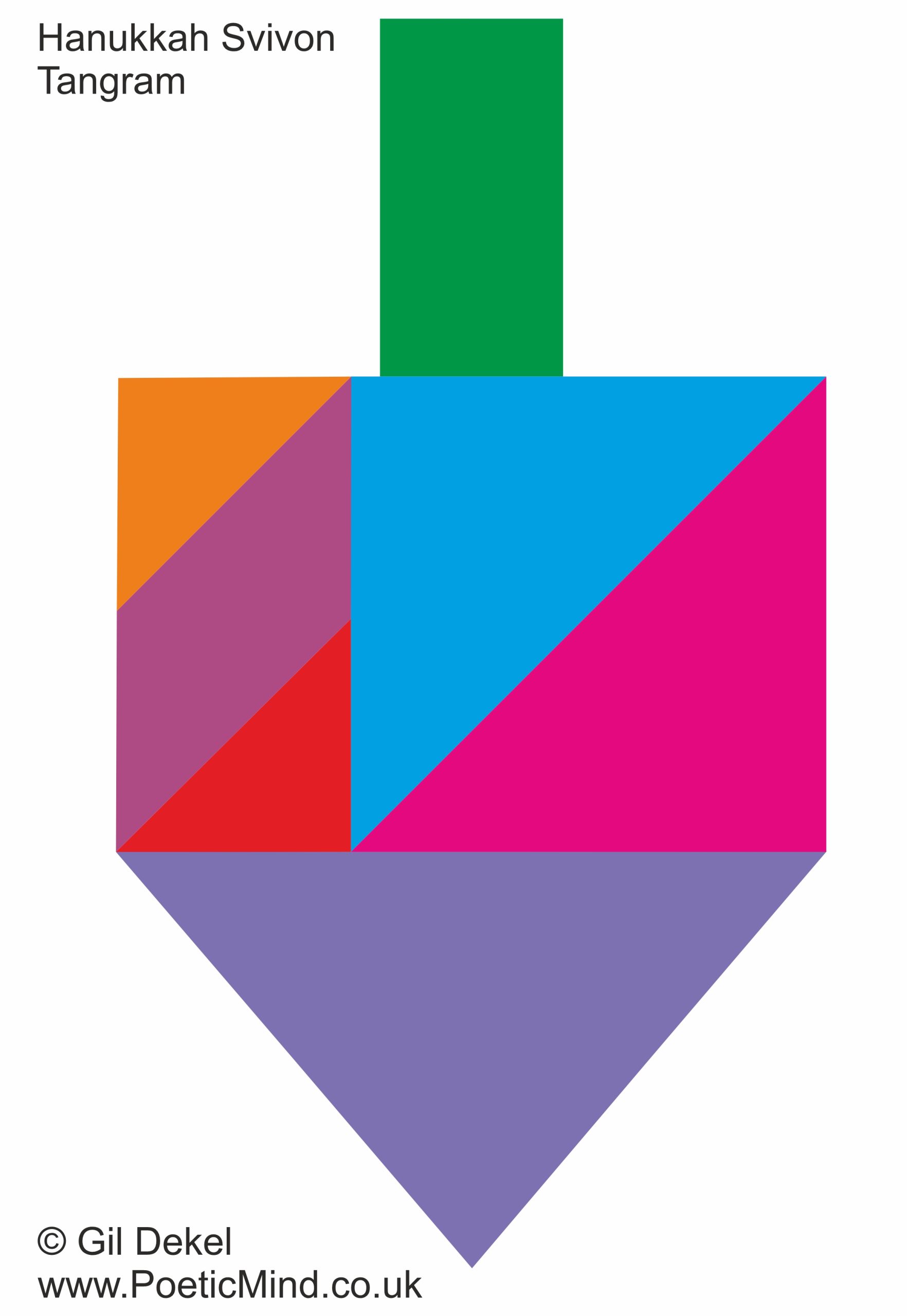
Pop-Up Beit Mikdash (temple) card.
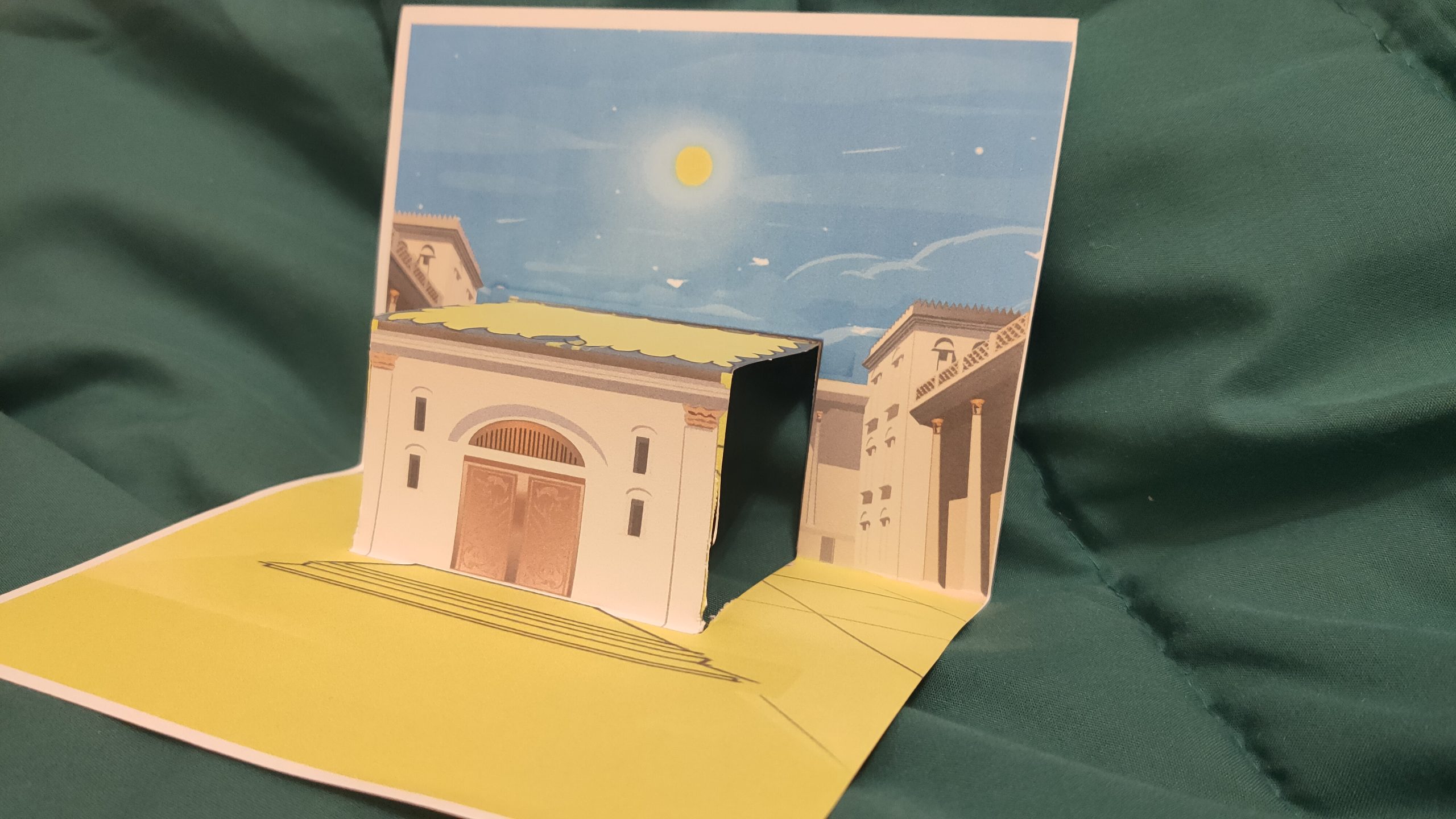
Template (print on A4 card, cut, colour and fold)…
Orange Menora
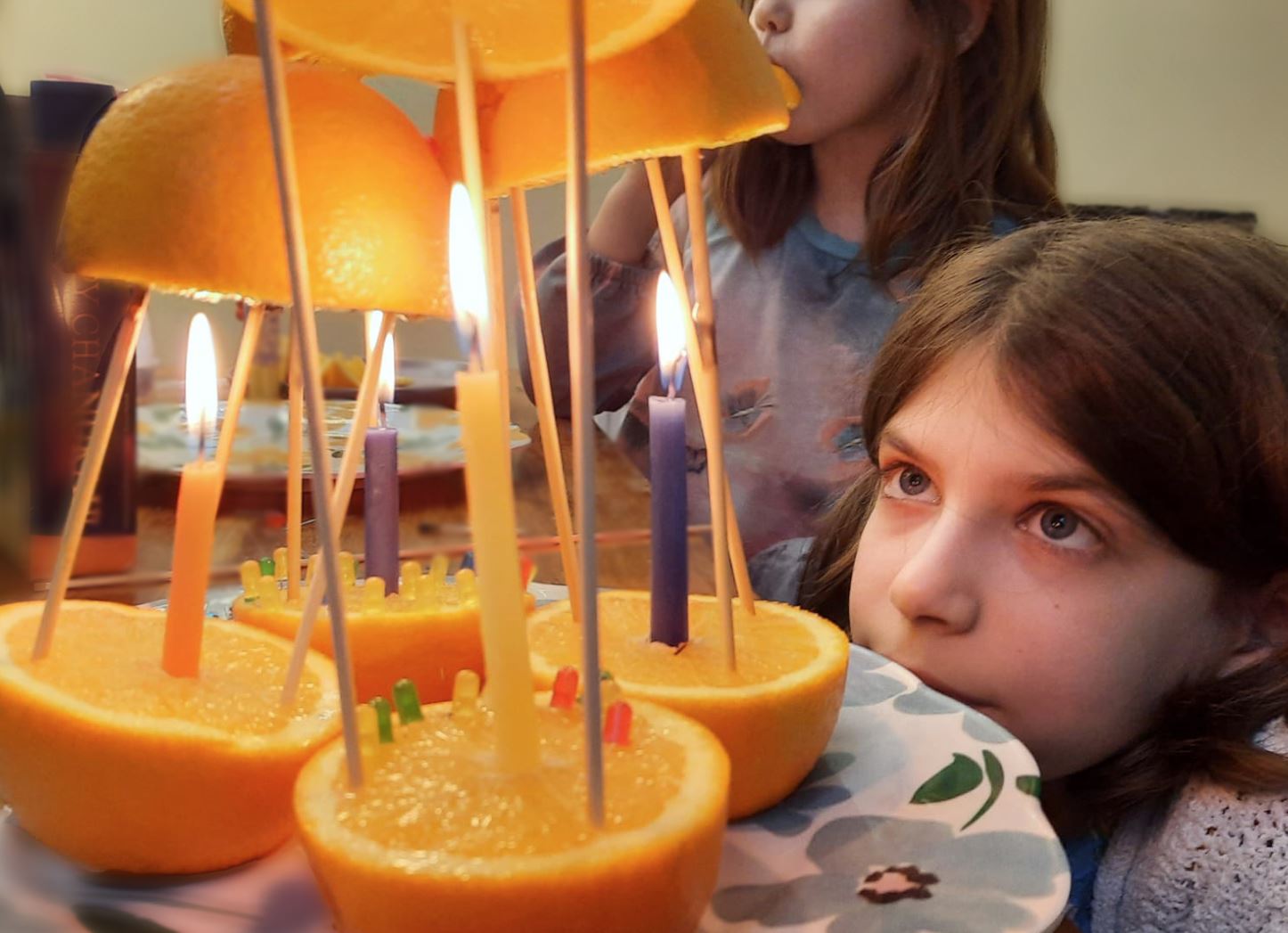
Hanukka story:
Hanukah is the Jewish Festival of Light. Some 2000 years ago the Ancient Assyrians-Greeks came to Israel, and they saw the temple in the middle of Jerusalem. The temple didn’t look like Greek temples, as it was very modest and simple building. The Greeks thought: “Oh, a building in such a central place of Jerusalem is perfect for our parties. This can be a club for parties!” They had a good disco party there; and in the process, they used up all the oil and made a lot of mess inside.
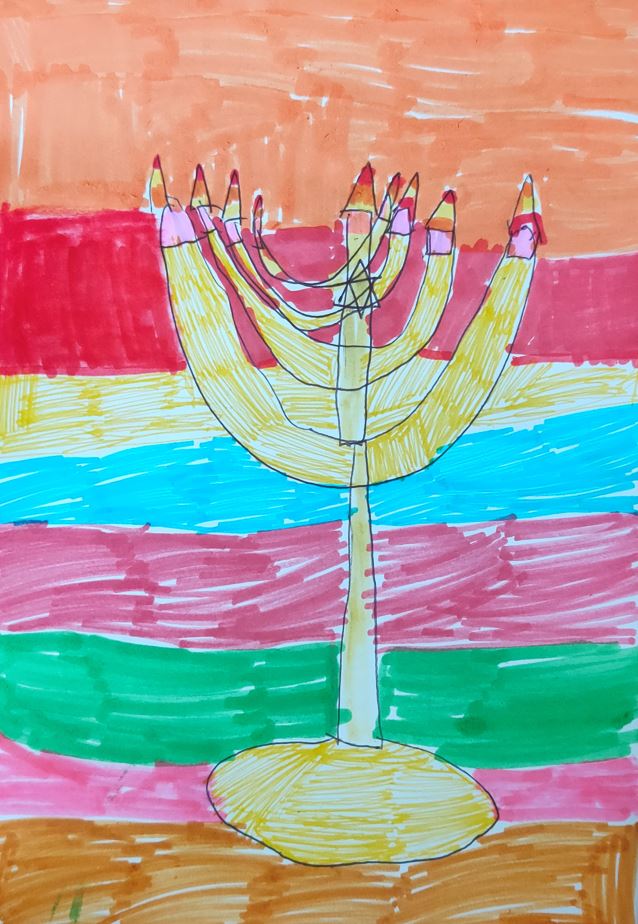
‘Hanukiya’ (‘Menora’) – by Nicole Dekel
One day, the Macabim family decided to clear up the space, so they can use the temple for special spiritual events and bring the Godly Light back into that space. They looked at the Menorah, the big candelabrum lamp that stood in the middle, and realised there was no oil left to light it up because all the oil was used up for the parties… apart of one little jar of oil which they found hidden. But there was so little oil in the jar, to last only for one day.
They poured the oil into the Menorah, and it burned beautifully a whole day. When they came back the next day, a miracle happened… the lamp light was still on. The oil that should have last for only one day was continuing to burn and glow; and light up the Menorah. And the oil held for eight days in a row! This miracle purified the temple, illuminated the space and brought magic and joy to all who saw it.
This is why we celebrate the light.
More art activities:
(Download PDFs Templates here)
1. Play The Yoga Candle game (watch video to learn how to play).
2. Make a spinning toy, Svivon.
(Template) 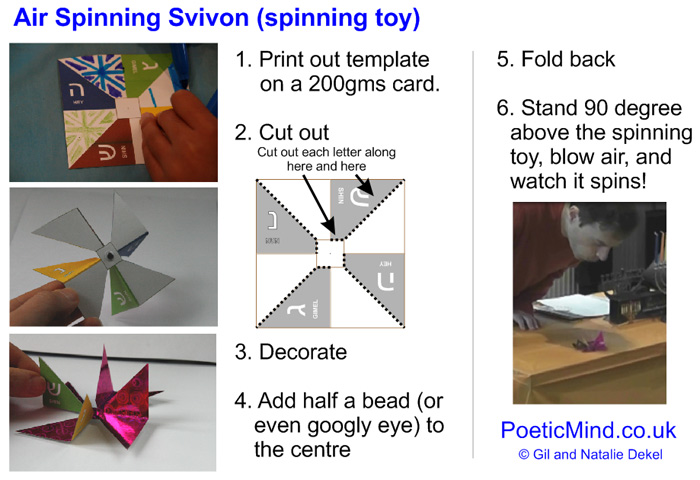
3. Make a Macabim paper puppet.
(Template)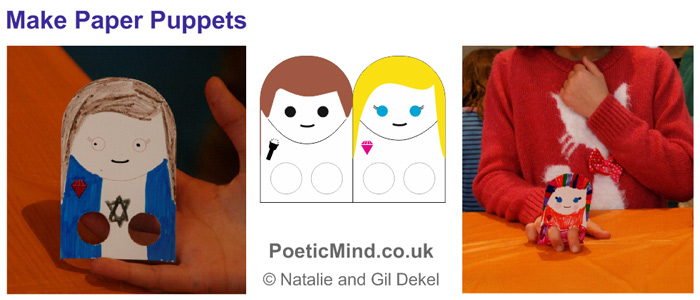
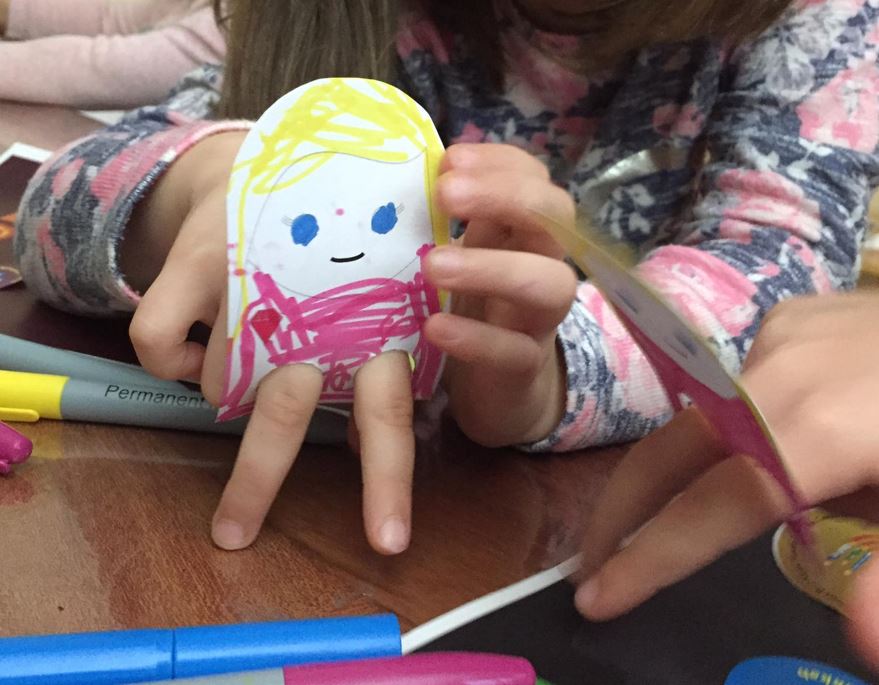
4. Dance the Macabim ‘Hora’ dance (watch the video above to learn more).
5. Make edible Chocolate Svivon (Spinning Toy).
We found cone shape sweet, and simply added chocolate sticks to it.
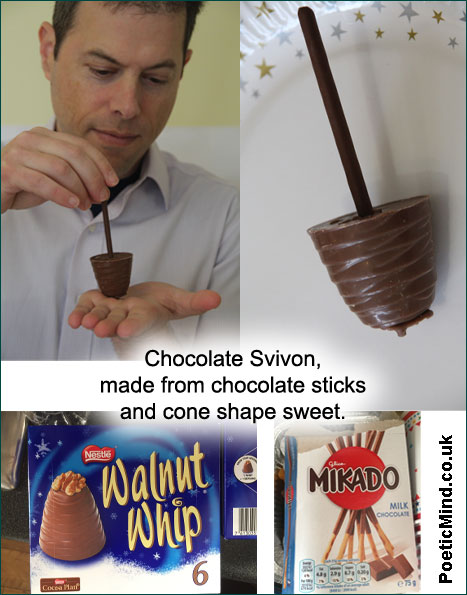
Another option is to make it with Meringues:
Ingredients: – Mini Meringues (tub of 28, from Sainsbuey’s UK). – Chocolate ‘flutes’ (sticks). – Glitter icing colourings. – Dark Chocolate.
Method: 1. Melt dark chocolate, and coat the meringues. 2. Once cooled, gently make hole in the back, and place chocolate ‘flutes’. It may break at first, and may take a few tries before you get it right. 3. Write letters using glitter icing colourings. 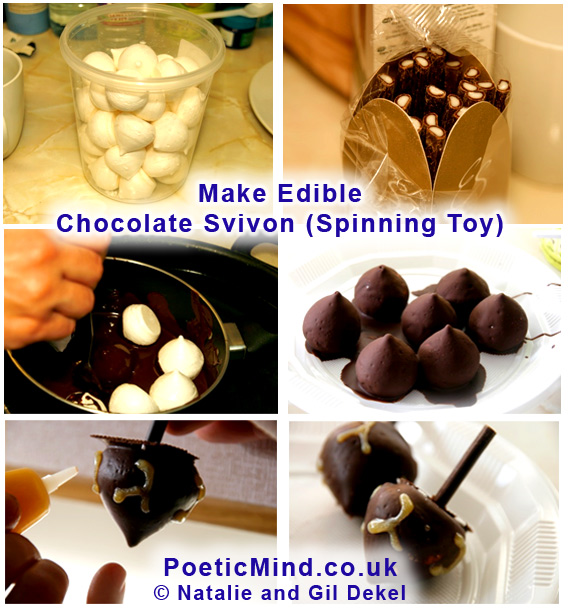
6. Share Israeli/British chocolate coins, and donuts ‘Sufganiot’.
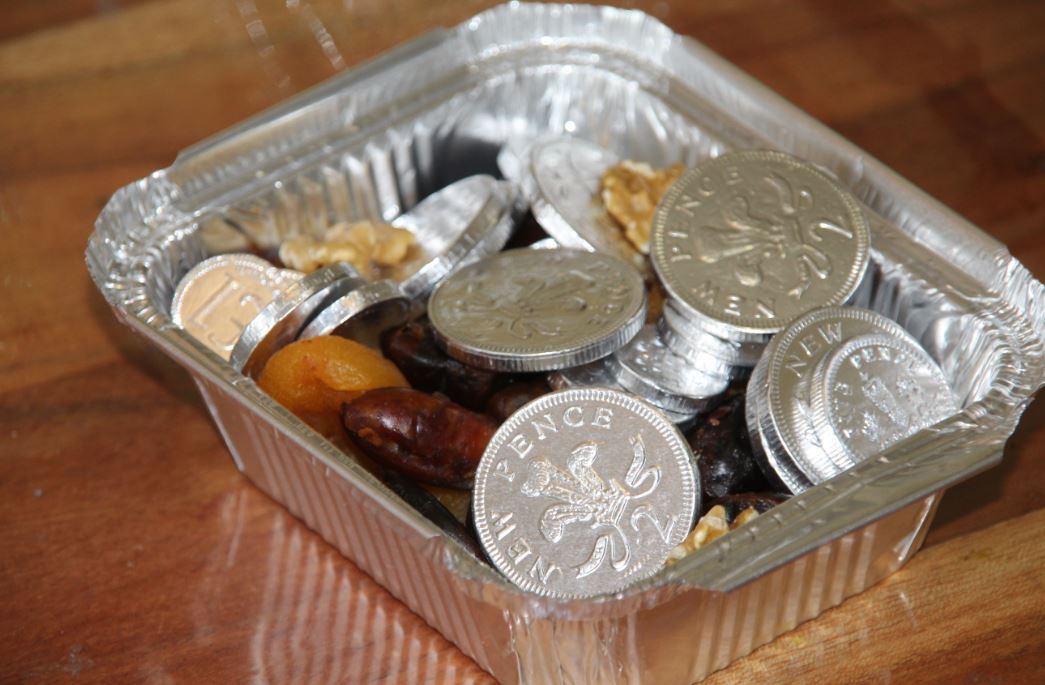
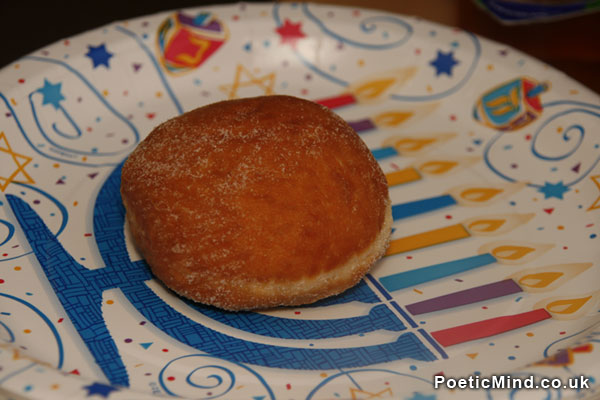
7. Build the Third Temple of Jerusalem.
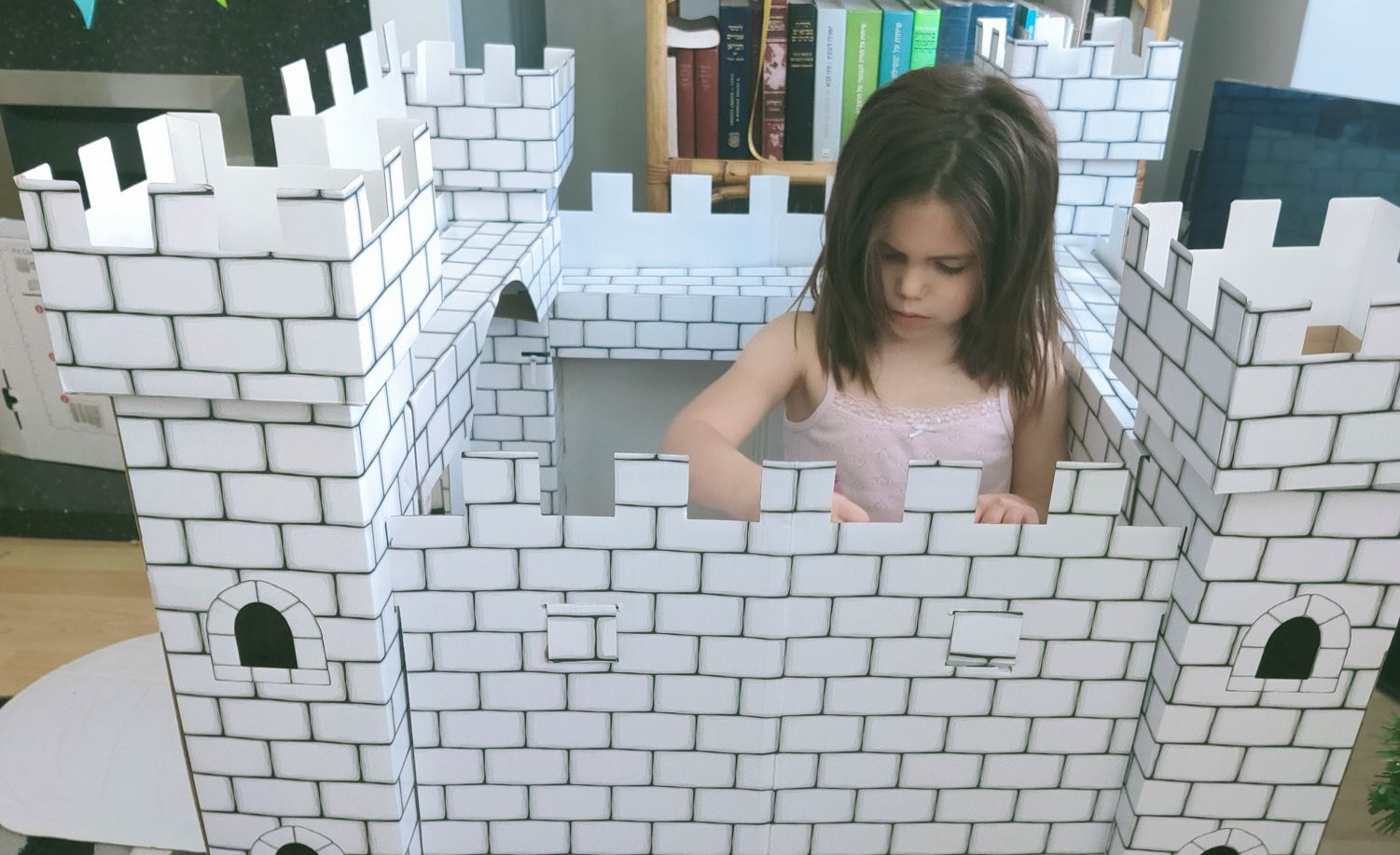
Use cardboards to build the temple.
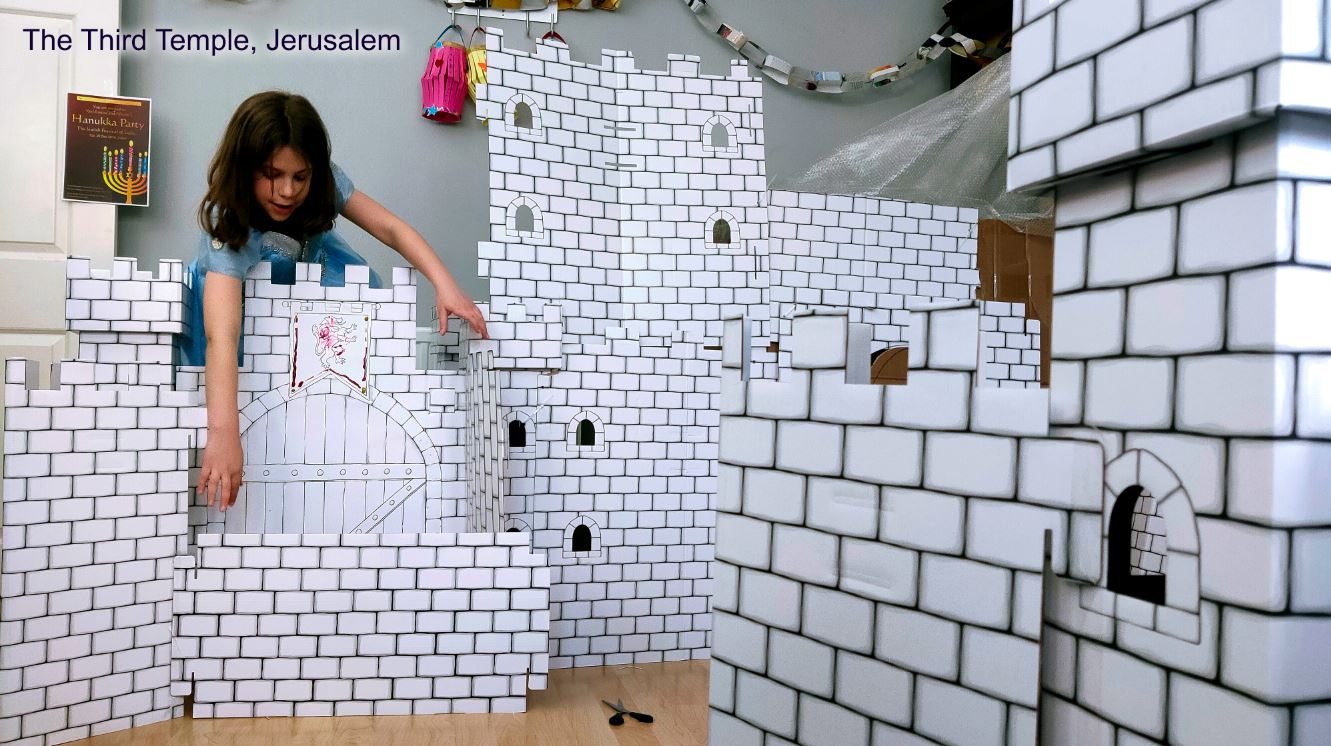
Use cardboards to build the temple.
8. Orange candle
We made a candle from an orange (or a clementine), using olive oil.
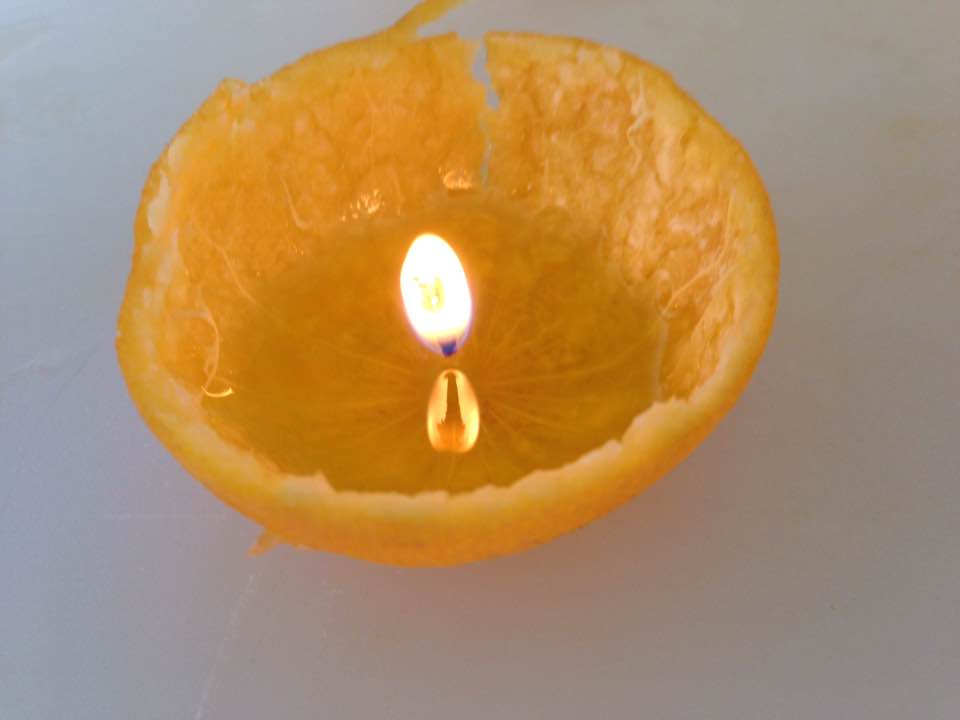
Make a candle from a clementine or an orange! (photo © Gil Dekel).
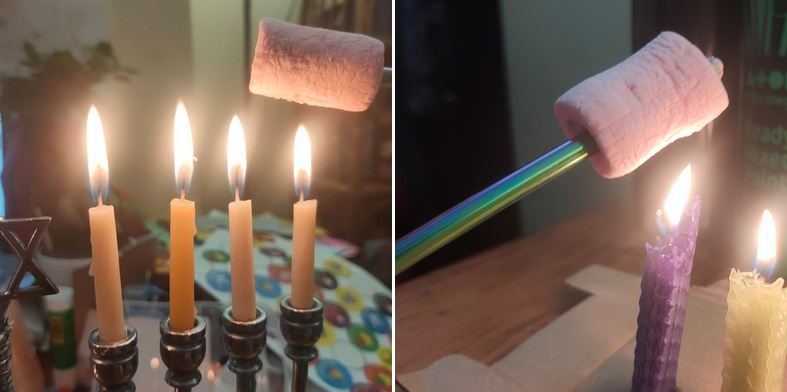
10. Draw something to do with the theme of Light (below, drawing of a rainbow):

11. Make Macabim chocolate coins with edible gold colour:
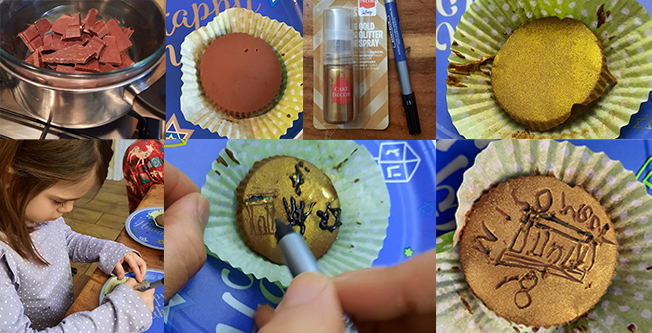
Macabim Chocolate Coins with edible gold food colouring
Decoration:
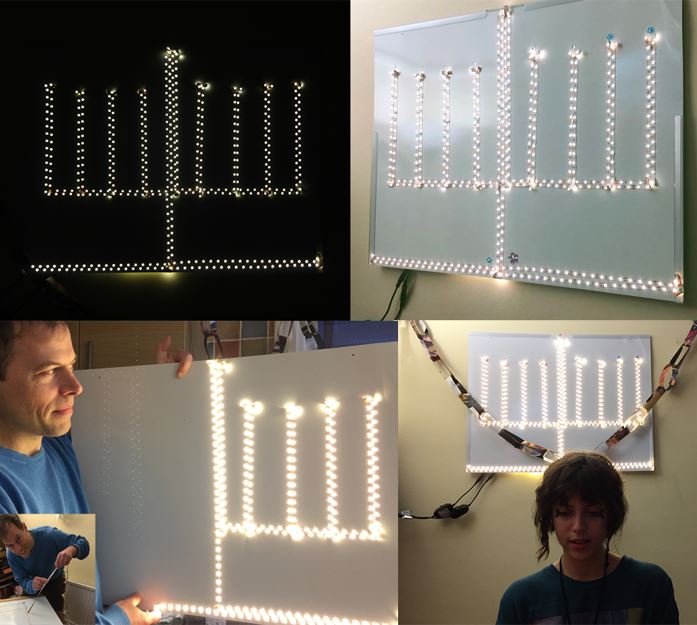
Make a LED light Candelabrum Hanukiya, for Hanukka. We bought LED Strip light which is self-adhesive.
The video below presents a more ‘traditional’ view of the holiday:
Hanukkah, also spelled Hannukah, Chanukah, Hanukah, Channukah, Chanuka, Chanukkah, Hanukka, Chanukka, Hannukkah, Channuka (Festival of Lights, Feast of Dedication, Jewish Feast of Dedication. Hebrew: חנוכה)
21 Dec 2013. Last updated 18 April 2024. © Gil and Natalie.

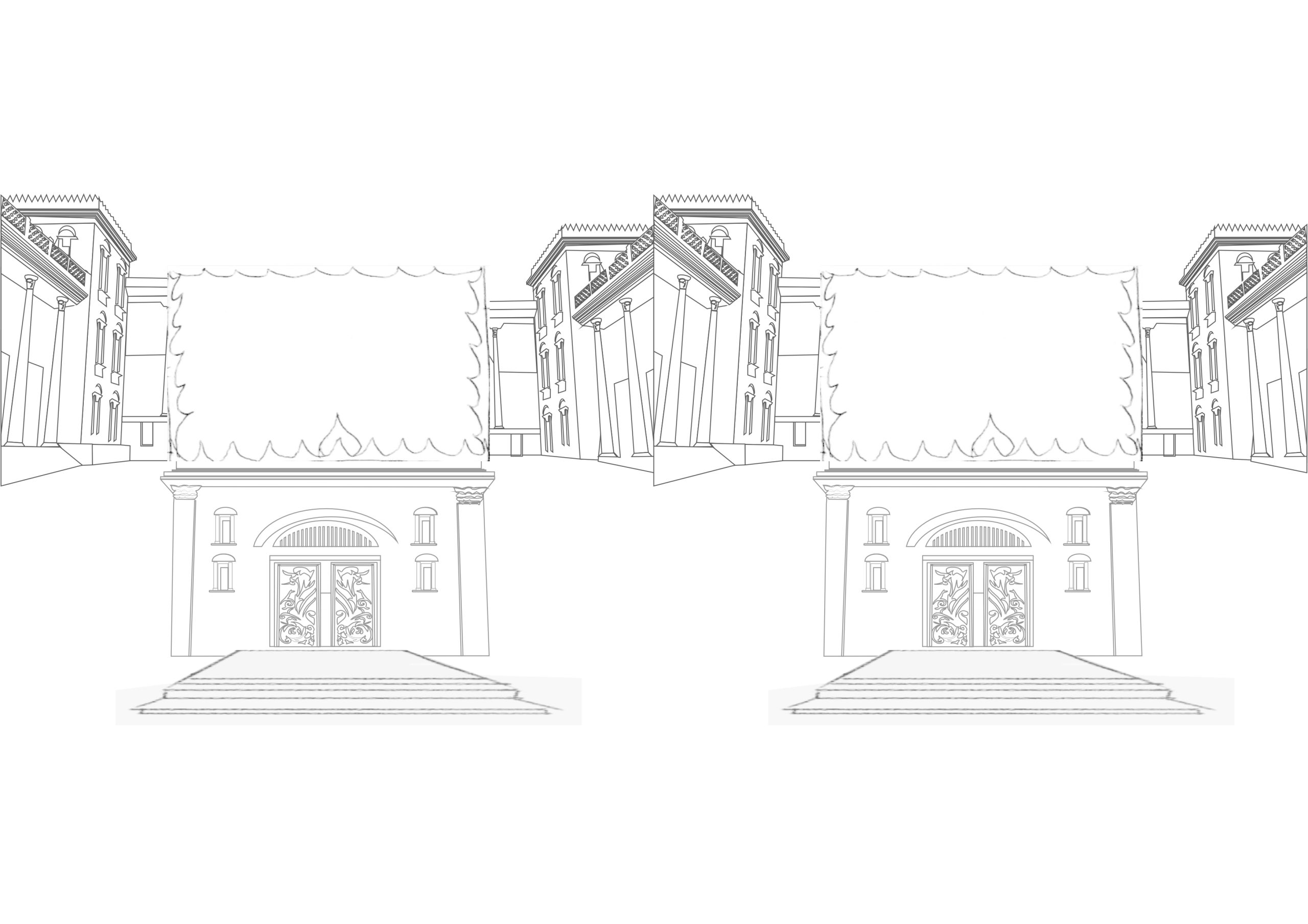
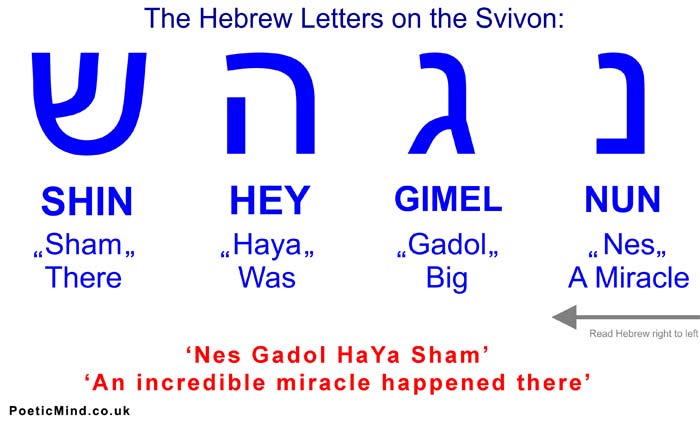
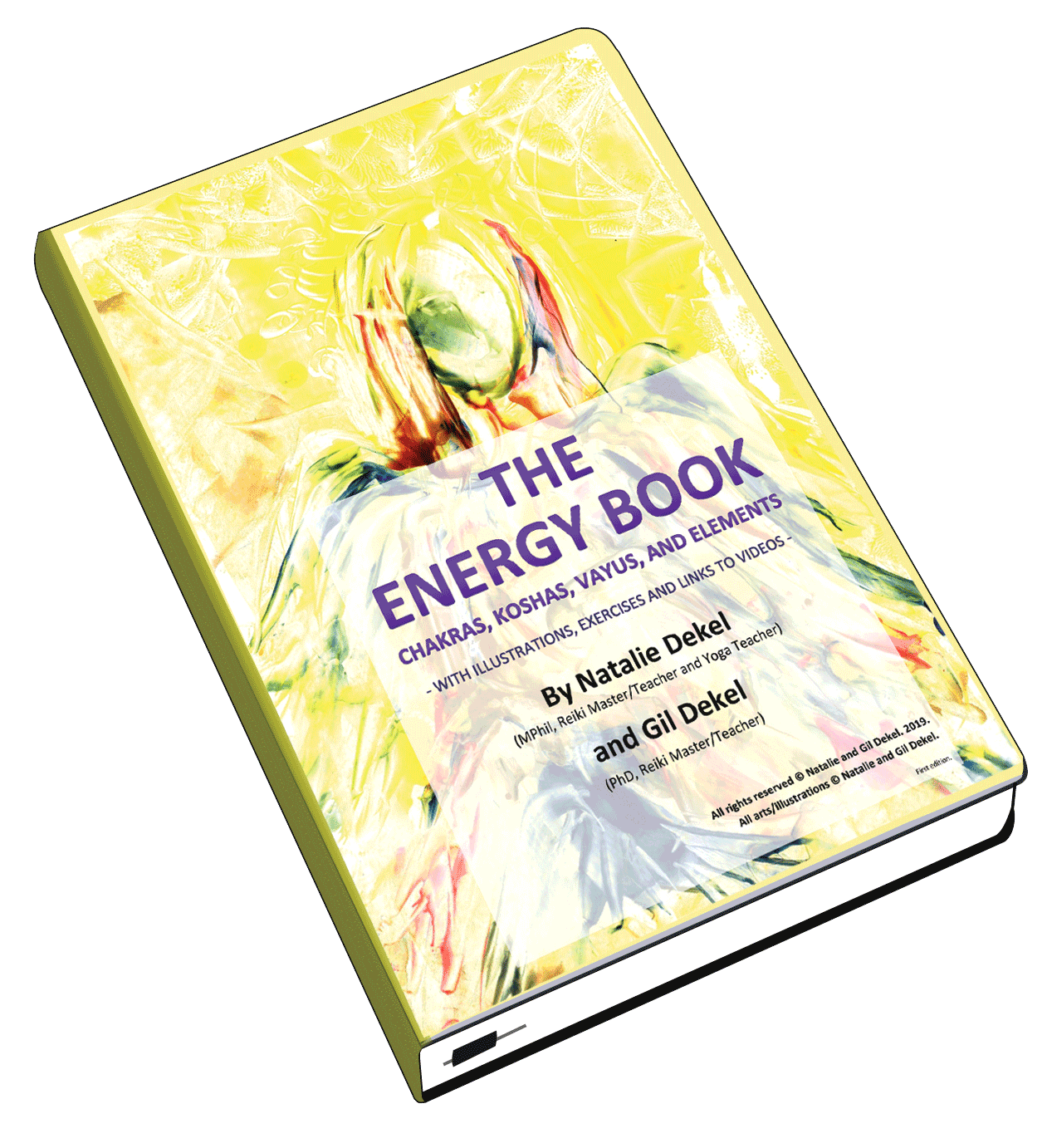
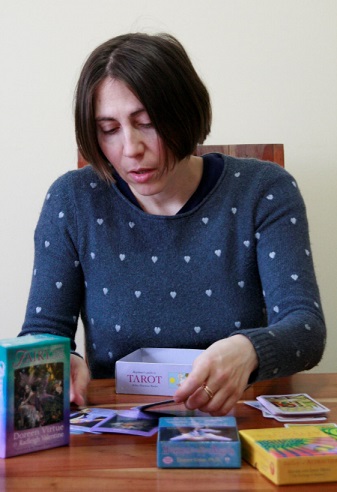 - Reading with Natalie, book here...
- Reading with Natalie, book here...